Samsung Galaxy S20 FE 4G Review: The Proof is in the Details
The Samsung Galaxy S20 FE is Samsung’s answer to the COVID-19 pandemic. Consumers aren’t so interested in buying $1,399 flagships anymore. With declining economies and a drastic reduction in purchasing power, consumers are more interested in getting the most bang for the buck than ever. This is the area where companies like Apple, OnePlus, and Xiaomi are focusing on this year, and Samsung wasn’t going to be left behind. Want the best of the Samsung Galaxy S20 at a cheaper price tag? Get the Galaxy S20 FE.
The Galaxy S20 FE seems to have it covered when it comes to the list of requirements of an affordable flagship in 2020: a standard size 6.5-inch 120Hz Full HD+ Super AMOLED display, a flagship SoC (Exynos 990 for the 4G variant, and the Qualcomm Snapdragon 865 for the 5G variant), enough RAM and storage, high-spec cameras (with the primary camera lifted from the Galaxy S20 and the Galaxy S20+), a big battery capacity (4,500mAh), fast wired and wireless charging, IP rating, microSD card slot, and a palatable price tag. However, it does miss out on a glass back (which could be a plus or a minus), a Quad HD+ Dynamic AMOLED display, a 3.5mm headphone jack, and super fast wired charging provided in the box.
The phone also has to contend with a field of competitors that is getting more crowded by the day. For the same or similar price bracket as the Galaxy S20 FE, you could get the OnePlus 8T, OnePlus 8 Pro, Xiaomi Mi 10T, Mi 10T Pro, and the Mi 10, ASUS ROG Phone 3, Realme X50 Pro, Apple iPhone 11, and others. Some of these competitors may even have better specifications in a few areas, but at the end of the day, the execution of specifications matters more than the specifications themselves.
Can the Galaxy S20 FE hold its own against such a broad variety of competitors?
Let’s find this out in our review.
Review Summary
| Pros | Cons |
|---|---|
|
|
Samsung Galaxy S20 FE Specifications
| Specification | Galaxy S20 FE 5G | Galaxy S20 FE 4G |
|---|---|---|
| Dimensions & Weight |
|
|
| Display |
|
|
| SoC | Qualcomm Snapdragon 865
Adreno 650 GPU |
Samsung Exynos 990
Mali-G77MP11 GPU |
| RAM & Storage |
|
|
| Battery & Charging |
|
|
| Rear Camera |
|
|
| Front Camera | 32MP, f/2.0 | 32MP, f/2.0 |
| Other Features |
|
|
| Android Version | One UI 2.5 based on Android 10 | One UI 2.5 based on Android 10 |
About this review: Samsung India sent us the 8GB RAM + 128GB storage variant of the Samsung Galaxy S20 FE 4G (SM-G780F). I have used the phone for thirteen days. Samsung had no input on the content of this article.
Samsung Galaxy S20 FE – Design

The Samsung Galaxy S20 FE’s design is fine and functional, but it’s not going to win design awards.
This is because of a few factors. First, let’s look at the build quality. The phone has a thin aluminum frame and a matte plastic back instead of using glass. For durability, this is a plus, as plastic won’t break like glass does. There is a potential for getting more scratches with plastic, but thankfully, Samsung has eschewed its traditional glossy coating in favor of a soft-touch matte coating, which should reduce the probability of scratches. The aluminum frame is thin because of the aggressively curved sides, but it’s durable as well.
The front is where the durability does hit a roadblock. The display is protected by Corning’s Gorilla Glass 3, which is four generations old now. The Galaxy Note 20 Ultra (review) has the latest Gorilla Glass Victus, and while hoping for its inclusion in the Galaxy S20 FE would have been a bit too optimistic, Gorilla Glass 6 should have been featured in an affordable flagship for better drop resistance. As it is, users are advised to use a case to protect their phone.
The power and volume buttons have acceptable rigidity and actuation feedback, but phones like the OnePlus 8 Pro are ahead here.

In terms of in-hand feel, the Galaxy S20 FE feels nice to hold in the hand. Its 6.5-inch display-diagonal isn’t too big, the sides and the back are comfortably curved, and the phone’s volume doesn’t present an issue, as the thickness (8.4mm) and weight (190g) are kept at acceptable levels. The phone is appreciably lighter than the OnePlus 8 Pro, but the Samsung Galaxy S20+ manages to keep the weight even lower (186g) even with the use of a glass back and a bigger 6.7-inch display.
The matte coating of the polycarbonate back feels a lot better than the glossy plastic Samsung uses in its cheaper M-series and A-series phones. In itself, it feels premium. However, a glossy glass back as seen on the Galaxy S20+ looks and feels more premium, although they get a lot more fingerprints. At the top of the hill are matte glass backs, as seen on the OnePlus 8 Pro, Samsung Galaxy Note 20 Ultra, and others. All of the phone’s competitors use glass backs, so in terms of feel, the Galaxy S20 FE is admittedly at a bit of a disadvantage here. Ultimately, it’s up to users to determine which build material and coating they prefer.
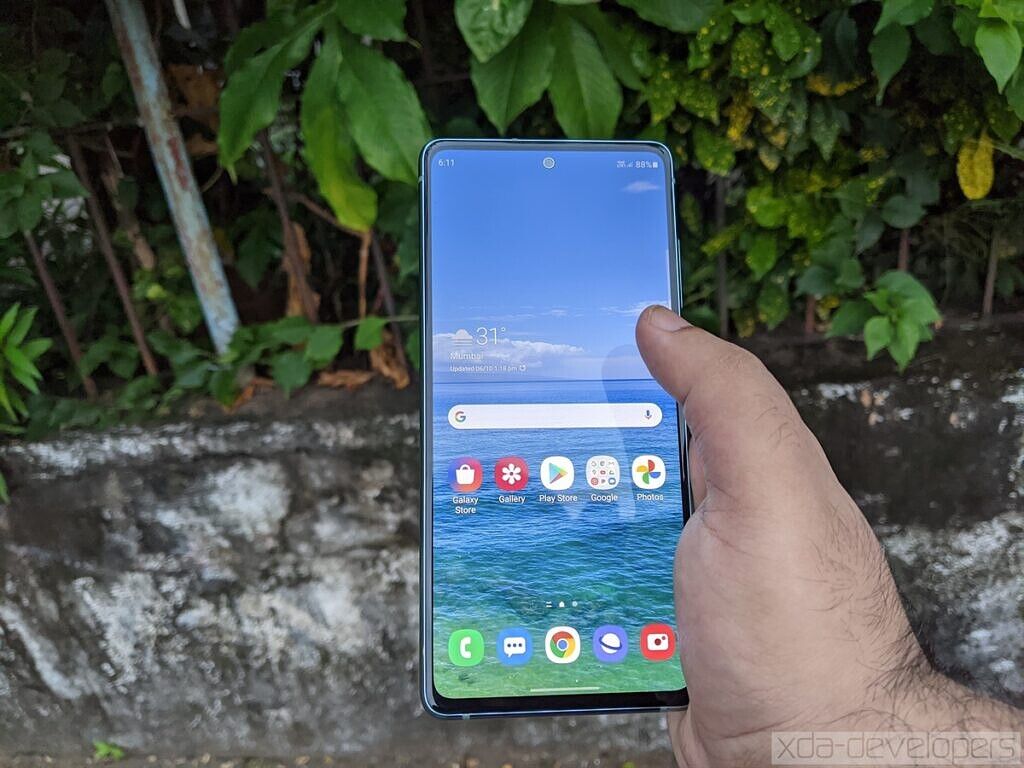
The front design of the Samsung Galaxy S20 FE is where Samsung lets us down. The phone features a small centered hole punch front camera cutout, which is good to see in itself. The cutout has a chrome ring around it, which could become distracting in certain types of lighting. It wasn’t a big issue for me, though. The centered location of the front camera is appreciable as it means primary status bar icons aren’t affected. However, the 84.8% screen-to-body ratio is puzzling to see, as it represents a disappointing regression from Samsung’s own previous affordable flagships, not to mention the price competitors in the market.
The bezels on all four sides are homogenously larger than what is seen on the Samsung Galaxy S20+, which has a 90.5% screen-to-body ratio. It means despite having a 0.2-inch smaller display (6.5-inch vs. 6.7-inch, both 20:9), the Galaxy S20 FE is just as tall as the Galaxy S20+ and is actually slightly wider. Its device volume is higher despite having less screen estate. The phone also doesn’t compare favorably here against competitors such as the OnePlus 8T (review) and the Xiaomi Mi 10T Pro (hands-on preview).
From the front, the Galaxy S20 FE still looks like a 2020 phone, but its design just isn’t as modern as that of the Galaxy S20+, and it makes a practical difference in screen size and device volume as well.


When we move to the back, we find Samsung’s late 2020 design language in play. The triple camera enclosure is placed at the top left, with the camera lenses being noticeably large, just like the Galaxy Note 20 series as well as the Galaxy Z Fold 2 (review). Aesthetically, it looks more pleasing than the Galaxy S20+’s camera enclosure. The phone does feature a camera bump thanks to the 1/1.7″ primary camera sensor, but it’s not big enough to be an issue of concern.




The color options of the Galaxy S20 FE are great.
It comes in Cloud Navy, Cloud Mint, Cloud Lavender, Cloud White, Cloud Orange, and Cloud Red. I received the Mint variant for review, and the color is subdued enough not to stand out too much, but it has understated good looks of its own. The variety of color options seen here is larger and better than what is seen on the Galaxy S20, Galaxy S20+ (review), and Galaxy S20 Ultra (review). The Mint color uses a nice shade of green, and in terms of aesthetics, it looks just as good as anything else on the market.
The Galaxy S20 FE features an IP68 rating for water resistance, and it has a hybrid microSD card slot as well (dual-SIM or single-SIM + microSD). However, the phone lacks a 3.5mm headphone jack, just like the Galaxy S20 series. Samsung doesn’t bundle a 3.5mm to USB Type-C adapter in the box, so if users need it, they will have to purchase it separately.
In terms of the contents of the box package, the Galaxy S20 FE makes an underwhelming case for itself. Wired earphones and a case are not pre-loaded in the box. The pre-loaded fast charger is a 15W Adaptive Fast Charger with a Type-C to Type-A cable, compatible with Qualcomm Quick Charge 2.0. This charger was pre-loaded with all Samsung flagship phones in the past, going all the way back to the Samsung Galaxy Note 4.
With the Samsung Galaxy Note 10 and the Galaxy S20 series, Samsung finally moved on to providing 25W USB Type-C Power Delivery 3.0 chargers with PPS and PDO. The 25W charger provided with the Galaxy S20 series is also available in the box package of cheaper phones such as the Galaxy M31s and the Galaxy M51, but the more expensive Galaxy S20 FE gets short-changed here with the 15W charger. The phone does support 25W fast charging, but users will need to purchase the charger separately or use any other compatible 25W PD 3.0 charger. This is one area where the Galaxy S20 FE disappoints compared to its competitors. The OnePlus 8T, for example, comes with a 65W fast charger in the box, while the Xiaomi Mi 10T Pro comes with a 33W fast charger. It’s strange to observe Samsung failing to keep up in such a basic area of competition.
Overall, the Galaxy S20 FE commits enough missteps with its design for it to be called slightly disappointing. Yes, it does pass the acceptability test, but it’s hard to deny that competitors are ahead here. In itself, the design and build quality aren’t bad at all—but at the same time, they are not going to be at the top of the design comparisons.
Samsung Galaxy S20 FE – Display
The Samsung Galaxy S20 FE has a flat 6.5-inch Full HD+ 1080p (2400×1080) Super AMOLED display with 20:9 aspect ratio and 407 PPI. The display features 120Hz high refresh rate, which Samsung refers to as high motion smoothness. Unlike the Galaxy Note 20 Ultra’s adaptive variable refresh rate implementation, the Galaxy S20 FE’s 120Hz implementation is carried over from that of the Galaxy S20 series, as it uses two discrete screen refresh rate modes: 60Hz and 120Hz. Samsung ships the phone with 120Hz mode enabled out of the box, unlike the Galaxy S20 series. The absence of a curved display can be a plus or a minus, depending on users’ perspectives. For most users, a flat display represents a better compromise.
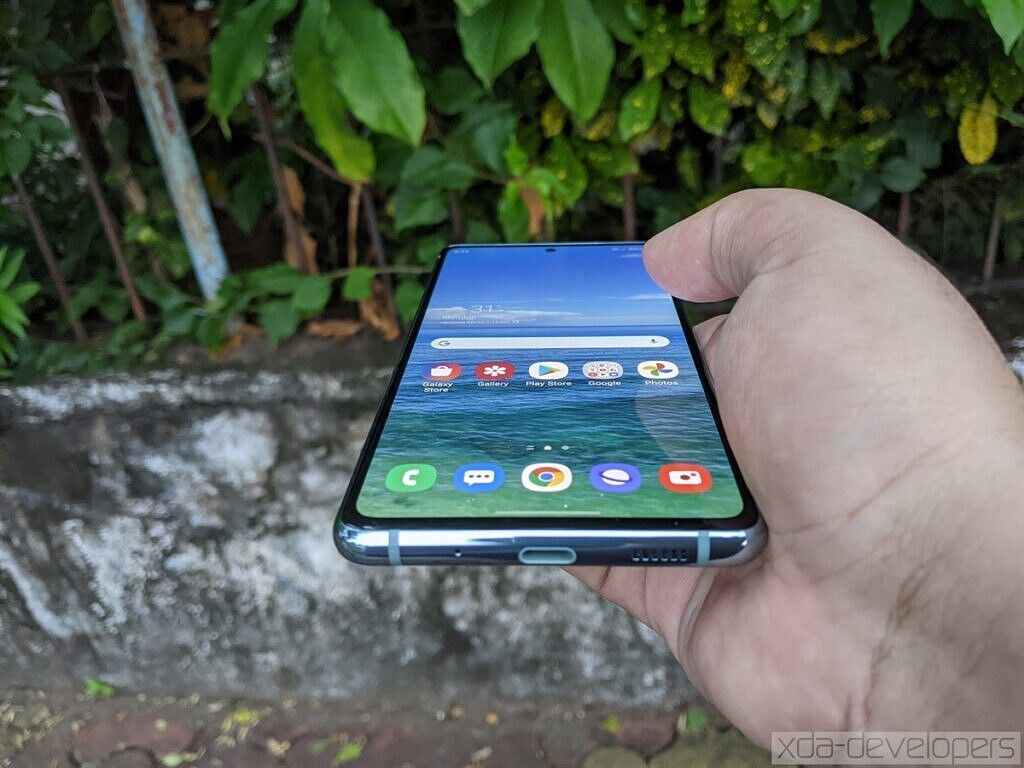
The Galaxy S20 FE has a Super AMOLED display, instead of having a Dynamic AMOLED panel. The older terminology means the display is not HDR10+ certified, unlike the flagship displays of the Galaxy S10, Galaxy Note 10, Galaxy S20, and Galaxy Note 20 series. It supports regular HDR10, as expected.
The Galaxy S20 FE’s display does lack QHD+ resolution. However, it should be considered that even the Galaxy S20 and Galaxy Note 20 series does not let you use the 120Hz mode with QHD+ resolution, as it can only be used with Full HD+ resolution (and the reason for that still remains unclear). It is generally agreed that 120Hz with Full HD+ resolution is a better experience than 60Hz with QHD+ resolution, so the absence of QHD+ is not a big issue on the Galaxy S20 FE because even if it did have it, you wouldn’t have been able to use it with the 120Hz mode. Yes, text and images won’t look as sharp as seen on the OnePlus 8 Pro (which does feature 120Hz support with QHD+ resolution), but the FHD+ resolution is still acceptable thanks to subpixel anti-aliasing.
The display of the Galaxy S20 FE features High Brightness Mode (HBM), which means sunlight legibility isn’t an issue, as the phone will be able to reach ~700 nits at 100% APL. The panel isn’t a latest-generation Samsung display, which means it has an older emitter. In turn, this means it won’t be able to go quite as bright as the displays of the Galaxy S20 and Galaxy Note 20 series, but usability even in direct sunlight shouldn’t be an issue as Samsung also switches to a special display mode with low gamma and increased display contrast whenever HBM is activated. When using manual brightness, the company continues to tune things conservatively as the maximum manual brightness is capped to ~350 nits at 100% APL. The minimum brightness of the phone is a positive as it can get very low, lower than the OnePlus 8 Pro, for example.
The contrast of the display is just as good as any other AMOLED display. The viewing angles, though, are disappointing because the display still features visible angular color shifting to blue as well as a rainbow out interference effect at extreme angles. Newer Samsung OLED panels have eliminated the rainbow out interference effect, and also reduced off-axis color shifting by a significant amount. The Galaxy S20+’s viewing angles, for example, are much better because the color shifting is much lower. Strangely, even the cheaper Galaxy M51 (review) doesn’t feature the interference effect issue (that is likely caused by the polarizer).
It’s also worth mentioning the display doesn’t feel as laminated to the glass as the Galaxy S20+’s display does. On the other hand, the oleophobic coating that Samsung uses continues to be excellent here, which means tapping and swiping on the display feels great.


The color accuracy of the Galaxy S20 FE should be perceptibly great for all but the most demanding content creators. The Vivid mode is set by default and it features saturated colors, but users are advised to change it to Natural to experience calibrated colors with respect to the sRGB and DCI-P3 color gamuts. There are still some weak points here and there such as a too warm white point of the display, and black clipping that can be improved. On the other hand, the display gamma and grayscale accuracy here feels noticeably better than the Galaxy S20+’s display.
In terms of power efficiency, it’s more of the same as the 120Hz mode has been observed to require a substantial amount on power. The battery life with 120Hz mode is noticeably lesser than using the phone with the standard 60Hz refresh rate. Adaptive refresh rate displays will help here, but even then, the impact on power efficiency of the Galaxy Note 20 Ultra’s variable refresh rate was only measured to be 8% by AnandTech. The Xiaomi Mi 10T series, on the other hand, features an adaptive screen refresh rate implementation with LCD instead of OLED. The Galaxy S20 FE doesn’t push any boundaries here, but users concerned more about battery life than motion smoothness will be glad to know that the 60Hz mode does result in longer uptime than 120Hz.
Overall, the Galaxy S20 FE’s display is marginally weaker than it should be. While it posts a strong showing in most areas, it’s let down by the higher amount of angular color shifting that is observed on the display. In this regard, even older Samsung displays such as the Google Pixel 3 XL are superior here, and even last year’s value flagship, the Galaxy S10e, has perceptibly lower color shifting. Samsung excels in areas such as brightness and color accuracy, but for the price point, the display of the OnePlus 8T, for example, will provide a better experience as it has HDR10+ support as well. The OnePlus 8 Pro’s display is probably the best in this price range, as long as users get a panel free from QA problems. The Galaxy S20 FE slots in below both of these competitors, while it remains to be seen how the Xiaomi Mi 10T series handles itself here.
Samsung Galaxy S20 FE – Performance
The Samsung Galaxy S20 FE 4G is powered by Samsung’s own Exynos 990 SoC, while the 5G variant of the phone features the Qualcomm Snapdragon 865 chip. We have compared both of these chips’ implementations in our OnePlus 8 Pro vs. Samsung Galaxy S20+ review comparison article back in July. We did an in-depth deep dive on the Exynos 990 in our Galaxy S20+ review, and took a brief look at its gaming performance in our Galaxy Note 20 Ultra review. Readers interested in learning more about the Exynos 990 stacks up against the Snapdragon 865 gold standard in the Android SoC market can check the aforementioned links.
The Exynos 990 is a triple-cluster chip consisting of two Exynos M5 big custom cores clocked at 2.7GHz, two ARM Cortex-A76 medium cores clocked at 2.5GHz, and four ARM Cortex-A55 little cores clocked at 2.0GHz. It features ARM’s Mali-G77MP11 GPU.
I ran a series of benchmarks to see whether there was any discrepancy in the scores relative to the Exynos 990’s implementation in the Galaxy S20+. It turns out there is, at least in some benchmarks. PCMark scores were slightly lower but within margin of error, while the Geekbench 5 scores were indistinguishable. The 3DMark scores, however, were significantly lesser than what I obtained on the Galaxy S20+. The CPU Throttling Test benchmark refused at first to even complete a 15-minute run because according to the software, it was heating up the phone far too much. I had to do that again. The Speedometer score was a bit lower (59.9 vs. 61.7). The GFXBench results were mostly similar to those obtained on the Galaxy S20+, and they showed the same GPU throttling issue that occurred when running a series of tests one after the other. Finally, in AndroBench, the Galaxy S20 FE was able to post some excellent figures, even though it doesn’t have the latest generation storage specification (UFS 3.0 vs. UFS 3.1).
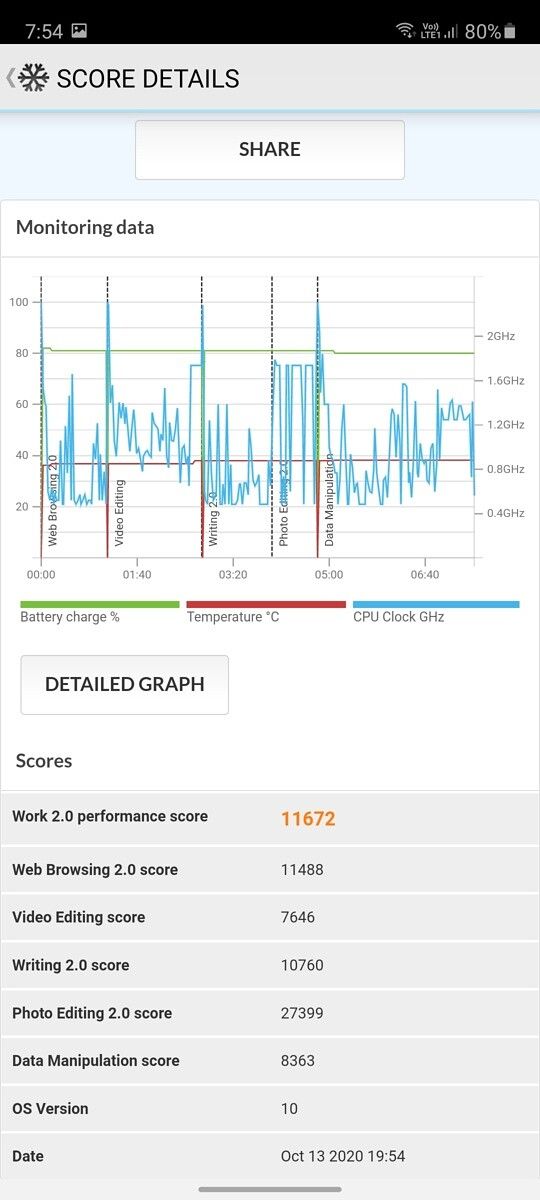
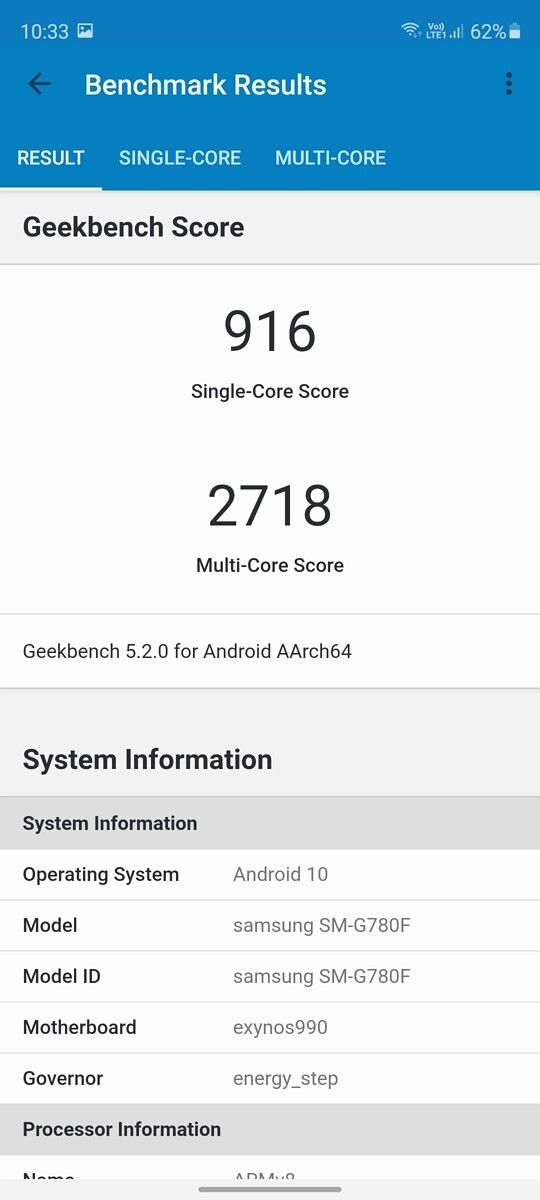
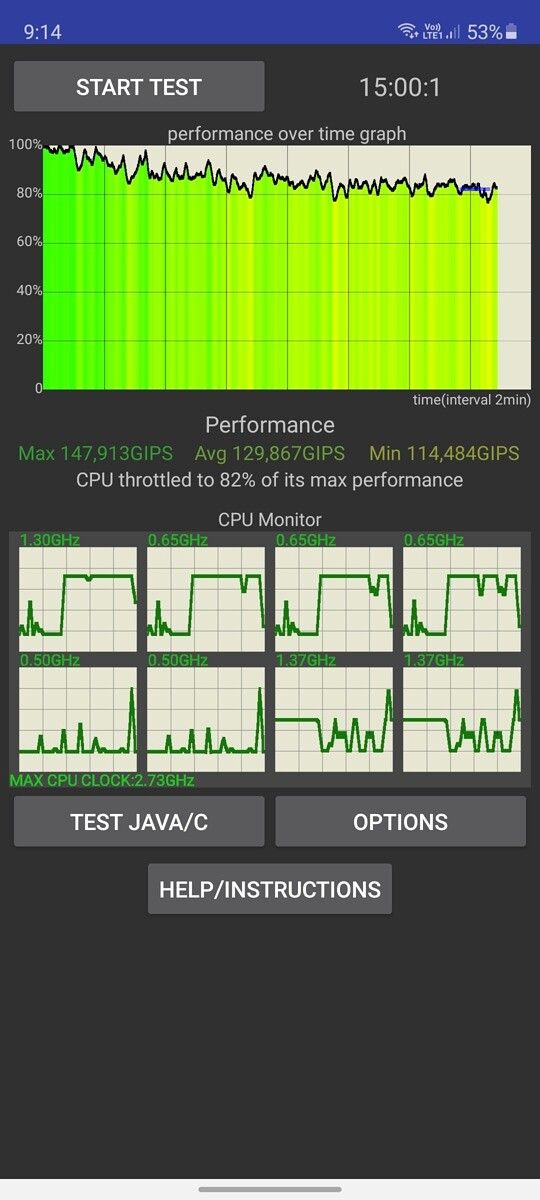
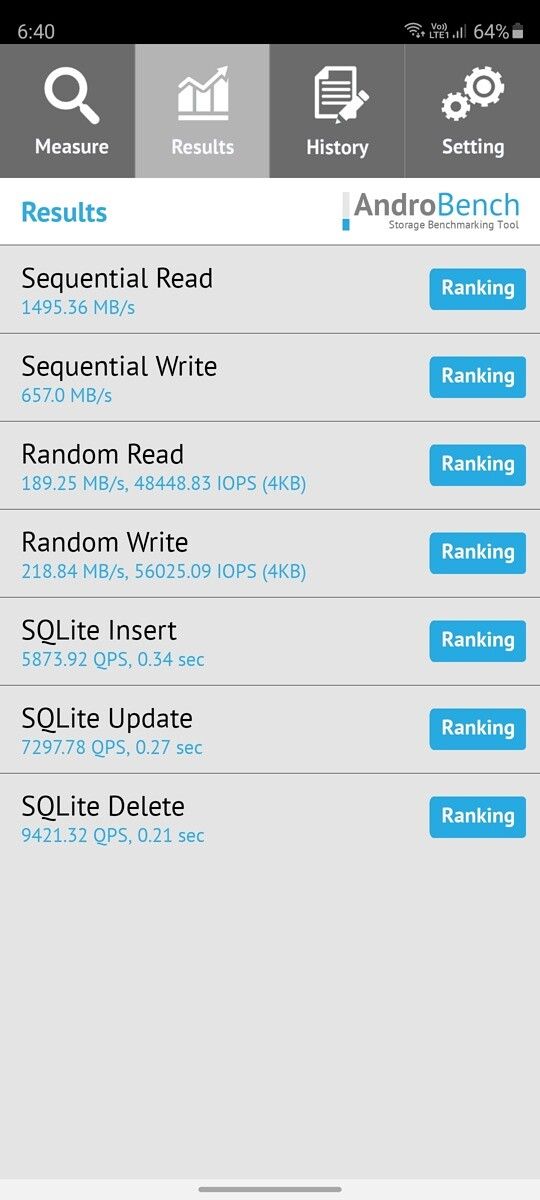

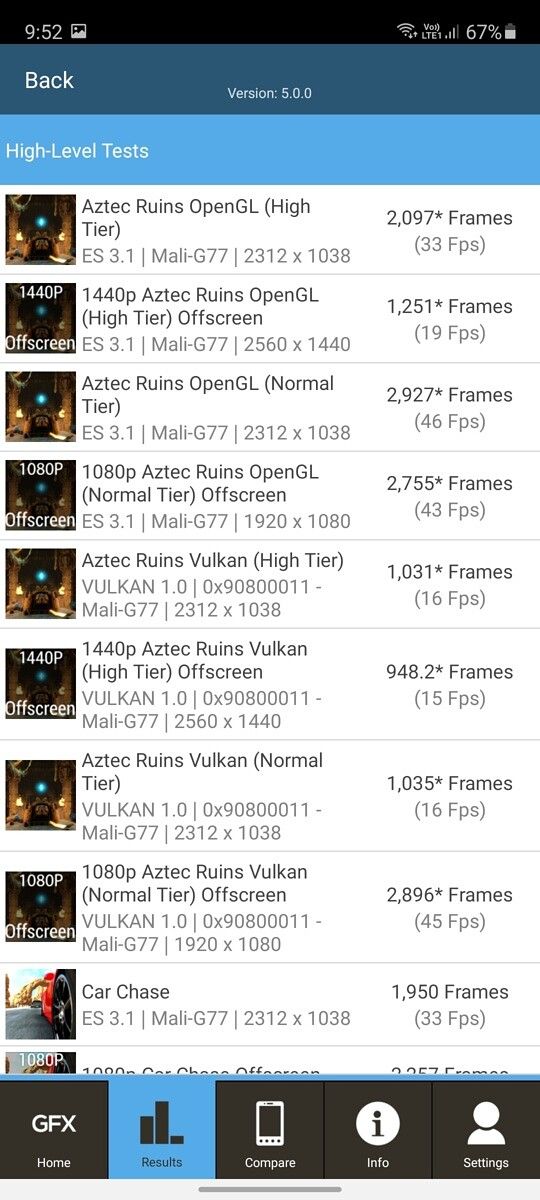
Ultimately, the conclusion of the performance benchmarks is that the Exynos 990 is an okay flagship SoC in its own right, but if the 5G variant of the Galaxy S20 FE is available for a higher price, I would recommend going for that as the Snapdragon 865 features superior CPU as well as GPU performance, while having much better CPU and GPU power efficiency as well.
UI Smoothness
To test how smooth the Galaxy S20 FE 4G runs, we run a modified version of Google’s open-source JankBench benchmark. This benchmark simulates a handful of common tasks you’ll see in everyday apps, including scrolling through a ListView with text, scrolling through a ListView with images, scrolling through a grid view with a shadow effect, scrolling through a low-hitrate text render view, scrolling through a high-hitrate text render view, inputting and editing text with the keyboard, repeating overdraws with cards, and uploading bitmaps. Our script records the draw time for each frame during the test, eventually plotting all the frames and their draw times in a plot along with several horizontal lines representing the target frame draw times for the four common display refresh rates (60Hz, 90Hz, 120Hz, and 144Hz.)














The test results are interesting. They quantify that as of current software, the Galaxy S20 FE is measurably less smooth than the Snapdragon 865 variant of the regular Galaxy S20. Even the Google Pixel 5 (review) with its mid-range Snapdragon 765G SoC is slightly smoother. The Bitmap Upload Test is where we are seeing the most variance between the Snapdragon Galaxy S20 and the Exynos Galaxy S20 FE (it’s not an apples-to-apples comparison since we don’t have both variants of the Galaxy S20 FE). The Exynos Galaxy S20 FE misses the 120Hz target in 97.1% of all frames in that test, which is a rather concerning result, while the Snapdragon Galaxy S20 does only so in 0.82% of frames. This could explain the stutters that can be felt sometimes in apps like Google Chrome when browsing particularly heavy websites.
However, to be fair, it should be noted that the phone does perform well in the other tests. The differences in all other tests apart from the Bitmap Upload Test are splitting hairs: you won’t notice the difference between 0.8% jank and 0.06% jank. The benchmark shows the importance of optimizing the software stack for high refresh rates. The Google Pixel 5 does a surprisingly good job here, while the ASUS ROG Phone 3 performs better than the Exynos Galaxy S20 FE but worse than the Snapdragon Galaxy S20. The ASUS ZenFone 7 Pro (review) is the top performer that we have seen in this test. For the most part, all of these phones will remain perceptibly smooth nearly all of the time.
In the default 120Hz mode, the phone is extremely fast and smooth nearly all the time.
In terms of real-world performance, I was mostly satisfied with the Galaxy S20 FE, but there are caveats. In the default 120Hz mode, the phone is extremely fast and smooth nearly all the time. However, it can still show minor frame drops after heavy multiple-tab sessions on Google Chrome (this happens mostly when entering and exiting the tab switcher). The UI runs at a buttery 120fps, though, and in general use cases, the real-world performance differences between the Snapdragon 865 and the Exynos 990 variants are likely imperceptible, something that wasn’t the case in previous generations.
The phone has a thermal limit where, after reaching 40°C, it will automatically drop back to 60Hz refresh rate until the temperature goes down. This limit is 2°C lower than what Samsung implemented on the Galaxy S20 series. It means that after heavy use, you will need to keep the phone down for a few minutes to let it regain its 120Hz capability.
With Exynos chips, there are always thermal issues to consider. While the Galaxy S20 FE performs well for the most part with respect to thermals, it does seem to start getting hotter earlier than Snapdragon 865-powered flagships. The problem is definitely not as severe as what I observed on the Exynos 9820-powered Galaxy S10e (review), but it still exists.
The RAM management of the Galaxy S20 FE is excellent. Samsung seems to have improved its memory management policies, as the DontKillMyApp benchmark reports a 100% result, which is good to see. In practical use, One UI 2.5 has better RAM management than OnePlus’ OxygenOS, as a higher number of apps, Chrome tabs, and services can be opened at any given time.
The Galaxy S20 FE uses a Goodix-sourced optical under-display fingerprint sensor, while the regular Galaxy S20 series uses Qualcomm’s first-generation ultrasonic fingerprint sensor. The fingerprint sensor of the Galaxy S20 FE has worked quite well for me. It is a bit slower than the fingerprint sensors seen on OnePlus devices, but the accuracy rate is great. In terms of accuracy, it is much better than the ultrasonic fingerprint sensors that Samsung uses in both the Galaxy S20 and Galaxy Note 20 series.
Overall, the Galaxy S20 FE’s performance is on par for the course. Yes, there are faster, smoother phones on the market, and some of these phones have better battery life as well. The OnePlus 8T and the Xiaomi Mi 10T Pro will both offer better performance. Even so, Samsung’s decision to place the Exynos 990 in the Galaxy S20 FE 4G is more acceptable than placing the same SoC in halo flagship phones like the Galaxy S20 Ultra and the Galaxy Note 20 Ultra.
The limitations of the chip are easier to forgive at this price point. Buyers will be aware, however, that Snapdragon 865-powered phones are now available for as less as ₹33,999, and the Xiaomi Mi 10T starts at ₹35,999. So users buying the Galaxy S20 FE 4G for performance alone are advised to head elsewhere, as it doesn’t head the CPU and GPU performance charts, although it does post excellent storage performance. For buyers interested in good-but-not-class-leading performance and who don’t place a top priority on GPU throttling and gaming performance, the Galaxy S20 FE will leave them satisfied.
Samsung Galaxy S20 FE – Camera Analysis
Camera specifications
The Samsung Galaxy S20 FE has a triple rear camera setup. The primary camera is the same as the one used in the Galaxy S20 and the Galaxy S20+. That means it has a 12MP Samsung ISOCELL S5K2LD sensor (which is a 1/1.7″ sensor), 1.8µm pixels, f/1.8 aperture, 26mm equivalent focal length, Dual Pixel PDAF, and OIS. The key characteristic of this sensor is that it uses a regular Bayer color filter array. Its lack of a high megapixel count means it doesn’t need a Quad Bayer filter array. The pixel size is natively high at 1.8µm, which is the highest seen in 12MP smartphone cameras (the pixel size is bigger than the iPhone 12 Pro Max’s 1.7µm pixels, for what it’s worth). Having Dual Pixel PDAF is also a plus as most Quad Bayer sensors opt to forego the feature, and this is the reason why the Galaxy S20 and the Galaxy S20+ had superior autofocusing capabilities than the higher-end Galaxy S20 Ultra.

The ultra-wide-angle camera has a 12MP 1/3″ sensor with 1.12µm pixels, f/2.2 aperture, and 123˚ field-of-view (FOV). This sensor doesn’t have autofocus, which means Super Macro capabilities aren’t possible. It’s not the same sensor as the Galaxy S20 series, as those phones had a bigger 1/2.55″ sensor with 1.4µm pixels. The Galaxy S20 series also doesn’t feature autofocus in the ultra-wide-angle camera.
The third camera is a telephoto unit. It has an 8MP 1/4.5″ sensor with 1.0µm pixels, f/2.4 aperture, 76mm equivalent focal length, PDAF, and OIS. The 76mm equivalent focal length relative to the 26mm equivalent focal length of the primary camera lets Samsung provide 2.9x optical zoom, which the company passes off as 3x. In addition, the camera has Samsung’s “Space Zoom” feature, which, in this case, means digital zoom up to 30x. The camera takes photos in 12MP resolution and not at its native 8MP, and the reason for that is unclear. In contrast to the Galaxy S20 and the Galaxy S20+, the Galaxy S20 FE has a real telephoto lens. Those two phones featured a 64MP secondary wide-angle camera with 29mm equivalent focal length and 1.1x zoom, relying on crop sensor zoom to provide 3x “hybrid optic zoom”.
In theory, neither of these approaches is specifically better than the other. The Galaxy S20 FE can have an advantage in daylight with real optical zoom, but in low light, it’s the 64MP camera and its crop sensor zoom that should end up on top as the poorer optics of the Galaxy S20 FE’s telephoto camera don’t let in much light.
Not having a 64MP secondary wide-angle camera means the Galaxy S20 FE misses out on giving users the option to take 64MP high-resolution Quad Bayer photos. These Quad Bayer photos can be variable; the Galaxy S20+’s 64MP image output was great, while the cheaper Galaxy M51’s primary 64MP camera took 64MP full-resolution images that had no advantage in detail over 16MP pixel binned photos.
Finally, the Galaxy S20 FE also skips on 8K video recording as it doesn’t have a high-megapixel sensor. This feature is a niche one currently, and its absence shouldn’t matter for most users.
On paper, the Galaxy S20 FE covers the requirement of three different focal lengths by providing wide-angle + ultra-wide-angle + telephoto cameras, something that the OnePlus 8T and the Xiaomi Mi 10T series miss out on by opting to forgo the telephoto camera. The Galaxy S20+’s 12MP primary camera took great photos in daylight and outdoor low light, so the Galaxy S20 FE has a strong foundation to start with.
The camera app of the Galaxy S20 FE is the standard One UI 2.5 camera app. I only have good things to say about it. To learn more about how it works, read our Galaxy Note 10 Lite review. In terms of autofocusing speed and shutter lag, the Galaxy S20 FE behaves well as most of the time, it takes photos with zero shutter lag (ZSL). In ultra low light, the Galaxy S20 series opted to forgo ZSL in favor of a mini-night mode with image stacking, but it doesn’t seem as if the Galaxy S20 FE does the same, at least in my testing. Samsung continues to make Scene Optimizer a user-configurable choice, and it’s enabled by default.
Image quality assessment – Daylight
Primary camera
The 12MP primary camera takes excellent photos in daylight, in general. However, the image processing here is different from what I saw with the Galaxy S20+, which had the same SoC and the same camera sensor. The dynamic range on the Galaxy S20 FE is narrower than the Galaxy S20+’s camera, which is a bit disappointing to see considering that dynamic range was such a strength of the Galaxy S20+’s camera. On the other hand, the Galaxy S20 FE retains the traditional Samsung strengths of great exposure, reasonably accurate colors and white balance, and well-defined shadow detail while retaining the highlights. On its own, the dynamic range here is on par with OnePlus cameras, but it doesn’t quite reach the lofty heights set by the higher-priced variants in the Galaxy S20 and Galaxy Note 20 series.
The Galaxy S20 FE retains the traditional Samsung camera strengths of great exposure, reasonably accurate colors and white balance, and well-defined shadow detail while retaining the highlights.
In terms of detail retention, the Galaxy S20 FE does well even in cloudy scenarios where there isn’t much light available. Samsung still uses aggressive noise reduction with low ISO levels, which means these photos are practically noise-free, at the cost of letting go of some fine detail. For the most part, though, they are sharp enough, even at 100% resolution. There isn’t much to complain about here. The OnePlus 8 Pro will take more detailed 12MP pixel binned photos at the cost of a darker exposure and lesser shadow detail. Both approaches have their plus points, but the Galaxy S20 FE remains competitive.
Ultra-wide-angle camera
The 12MP ultra-wide-angle camera has a wide 123˚ field-of-view. Its lower sensor size, pixel size, and lack of autofocus are all negatives, but in general use, the resulting photos come out bright, reasonably color accurate (the color science between all three cameras is the same, which is a plus), and with adequate detail.

At 100% resolution, the detail levels in photos do fall off quite a bit. When coupled with the lack of luminance noise thanks to aggressive noise reduction, the oil painting effect is unfortunately visible in some samples. It’s not the best ultra-wide-angle camera I have ever used, as the ultra-wide-angle cameras of the OnePlus 8 Pro and the Galaxy S20+ are significantly superior. However, the Galaxy S20 FE’s ultra-wide does do the job for all but the most discerning users.
Telephoto camera
As mentioned above, the 8MP telephoto camera of the Galaxy S20 FE takes photos in 12MP resolution for some reason. The 3x zoom samples have a good amount of detail, and the exposure is on point too. Despite the OIS, some of the samples came out a bit blurry. The dynamic range here is, as expected, worse than the other two cameras. The 3x zoom samples are, for the most part, as sharp as they should be.
3x is the optimal zoom level for this focal length. Jumping above 3x means the camera is simply zooming digitally. While digitally zoomed photos at 4x and 5x are still passable, the quality falls off dramatically at 10x zoom and above, as expected. The 30x Space Zoom feature is a gimmick, but this doesn’t come as a surprise.
Overall, the Galaxy S20 FE takes great photos in daylight. Its absence of a high-megapixel sensor means it can’t take 48MP or 64MP high-resolution photos, but 12MP should be enough for most users. The dynamic range of the primary camera is less than that of the Galaxy S20+’s camera, which is the one negative. The ultra-wide-angle camera doesn’t match that of its higher sibling, but still takes acceptable photos. Lastly, the telephoto camera may not be as holistically useful as an ultra-wide, but its image output at the 3x zoom level is good enough for viewing at full resolution.
Image quality assessment – Indoors and low light
The Galaxy S20 FE’s camera performs very well in daylight, but it does start running into issues indoors. The issue it falls into is smoothing. Smoothing fine detail to remove luminance noise is a poor thing to do. While it doesn’t make a big difference when taking photos of objects, it does have an adverse impact when taking photos of humans. That is because Samsung still enables aggressive facial smoothing by default. Even when you disable it in the camera app, facial detail is smudged by aggressive noise reduction, which means photos of humans just don’t have as much detail as photos taken from the OnePlus 8 Pro or any Google Pixel. Instead, they look overly soft, which is disappointing to see.
Enabling Samsung’s night mode here only makes things worse. In this respect, Samsung has regressed from last year. The company introduced a good night mode for its time a few months after launching the Galaxy S10 series, and I reviewed it on the Galaxy S10e. Since then, the image processing of the night mode has gone backwards, particularly when using it to take photos of people. Artifacts, over-sharpening, and unnaturally increased contrast are what you get from Samsung’s night mode on the Galaxy S20 FE, and it just reflects poorly on the company. The situation looks even worse when you consider that other vendors such as Google, OnePlus, Apple, and Huawei have it figured out. Google’s Night Sight is much better than Samsung’s new night mode, and they were actually quite close last year. It has to be hoped that Samsung can and will improve things in this respect with future software updates, because right now, the Galaxy S20 FE’s night mode is worse than the OnePlus 8 Pro’s Nightscape mode, for example.
In outdoor low lighting, the Galaxy S20 FE’s primary camera takes bright, detailed photos. The 1.8um pixel size shows its worth here. Photos do have luminance noise, but their detail levels and good exposure make up for that. The Galaxy S20 FE is not a low-light photography master, as Huawei, Google, and OnePlus are all ahead. However, the image quality is good in itself. Using night mode here increases the light intake but reduces fine detail to the point where you would be better off using the regular Photo mode instead.
Night mode is beneficial for the ultra-wide-angle camera in low light, though. The ultra-wide functions poorly in low light in the regular mode, but using night mode will rescue the image quality output from poor to something that is legitimately usable.
The Galaxy S20 FE lacks a dedicated macro camera and also doesn’t have autofocus in its ultra-wide-angle camera. This means it simply can’t get as close to the subject for Super Macro abilities. It’s a niche use case, but users hoping to see that feature here will be disappointed. On the other hand, regular macro photos come out great as the camera’s plane of focusing is wide enough for objects to remain in focus. It’s a better camera for food photography than the OnePlus 8 Pro, for example. The Live Focus portrait mode also does the job, as expected, even though it’s let down by facial smoothing, which was also expected.
Overall, the Galaxy S20 FE’s camera stumbles a bit in indoor and outdoor low lighting situations. The problem is that Samsung’s regression here was entirely self-inflicted. I can only help but imagine how much better the camera would be if Samsung figured out the issues with its 2020 night mode and got back to processing images in an authentic manner like Google’s Night Sight or even its own 2019 night mode. As it is, it still is a good smartphone camera for taking photos in low light, but there are better options available for only slightly higher price points.
In conclusion, the Galaxy S20 FE’s camera straddles the line between being called a “good flagship smartphone camera” and “a great flagship smartphone camera” for photos. With a better night mode, it would probably have been excellent, but as it is, there remains some work here for Samsung to do here even when considering that image quality in daylight is excellent.
Video recording
The Galaxy S20 FE is competent when it comes to video recording. It can record video in up to 4K at 60fps, and it supports recording in the HEVC encoder. Recording video with the ultra-wide-angle and telephoto cameras is supported. EIS + OIS is enabled in 30fps video recording modes, while OIS remains active in 60fps modes. The phone can record video in HDR10+ thanks to a Labs feature that is disabled by default. It supports Super Steady mode with both the primary and ultra-wide-angle cameras. Finally, super slow motion video recording is supported at 1080p at 960fps, and regular slow motion is supported as well.
I recorded quite a few videos using different settings such as 4K at 60fps, 4K at 30fps, 1080p at 60fps, 1080p at 30ps, Super Steady 1080p at 30fps, and Super Steady ultra-wide 1080p at 30fps. These videos have been uploaded to YouTube and are available for viewing below.
Suffice it to say that the Galaxy S20 FE does a good job in video recording. Its videos aren’t quite as detailed as that of the Galaxy S20+ in 4K, but it still manages to establish itself in the upper tier. HDR10+ video recording remains a great feature, and Super Steady works well enough as well.
Samsung Galaxy S20 FE – Battery Life and Charging




The Samsung Galaxy S20 FE has a 4,500mAh typical battery capacity, matching the battery capacity of the Galaxy S20+ while having a smaller, older-generation display. It features the same Exynos 990 SoC. Predictably, the results are quite similar.
Even after many updates, I was never happy with the battery life of the Galaxy S20+ in its 120Hz mode, and the same is true for the Galaxy S20 FE in the 120Hz mode. The phone can last for a full day (20-24 hours) of unplugged time with screen-on time ranging from four to five-and-a-half hours, although you could get as much as six hours of screen-on time or as low as four hours of screen-on time depending on your workload. Dropping the display refresh rate to 60Hz does increase screen-on time by a full hour, just as it did with the Galaxy S20+. What remains a fact is that this isn’t the battery life a user would normally expect with a 4,500mAh battery capacity. The power draw of the 120Hz mode coupled with the power efficiency deficit of the Exynos 990 isn’t a very good combination. Users of the Snapdragon 865-powered Galaxy S20 FE 5G are already reporting screen-on time in excess of six to seven hours, which shows the difference.
In terms of wired charging, the Galaxy S20 FE takes 1 hour and 10 minutes to charge from 15% to 100% using Samsung’s own 25W PD 3.0 charger, which was pre-loaded with other Galaxy S20 variants as well as the Galaxy M51. The charge time is acceptable with the 25W charger, but if you use the pre-loaded 15W charger, it should increase to about one hour and forty-five minutes.
The Galaxy S20 FE supports fast wireless charging (15W), and also supports PowerShare (9W), which is Samsung’s term for reverse wireless charging to charge smartwatches and TWS earphones.
Samsung Galaxy S20 FE – Odds and Ends
- The stereo speakers of the Samsung Galaxy S20 FE aren’t quite as loud as those of the Samsung Galaxy S20+. However, audio quality is good, and there is no distortion at high volume levels.
- The vibration motor of the phone is also not as strong and well-defined as that of the Galaxy S20+ or other phones such as the OnePlus 8 Pro, OPPO Reno 10x Zoom, Google Pixels, and others. Haptic feedback when typing feels a little weak, and other price competitors are ahead of the Galaxy S20 FE here.
- The 4G variant of the Galaxy S20 FE doesn’t support 5G (obviously). This means it’s hard to make a futureproofing argument for the phone in regions where 5G is stated to arrive within the next couple of years, such as India. Some consumers will have moved on by then, but as it is, it would have been nice for Samsung to make both 4G and 5G variants available in all markets.
- The cellular call quality of the phone was good and on par for the course, as expected. Dual VoLTE and VoWiFi support is included.
- The phone runs One UI 2.5 on top of Android 10 out of the box. It’s slated to get an update to Android 11-based One UI 3.0 in the coming weeks and months.
Conclusion and Final Thoughts

The Samsung Galaxy S20 FE is a fine phone. While I was uneasy recommending the Galaxy S20+ because of its extremely high price of ₹73,999 (which has since increased to ₹77,999 in India), it’s a lot easier to recommend the Galaxy S20 FE. Of course, ₹49,999 in India, £599 in the UK and €649 in the EU isn’t a small amount to pay, even for an affordable flagship. Therefore, let’s look at the pros and cons.
The Galaxy S20 FE’s list of pros includes a fast and smooth 6.5-inch 120Hz AMOLED display, nice matte plastic back and plentiful color options, good real-world performance, appreciable camera image quality in daylight and outdoor low light, excellent video recording, accurate optical under-display fingerprint sensor, and feature-rich software. Its list of cons includes a relatively low screen-to-body ratio, off-axis color shifting in the display, GPU throttling, smoothing issues with facial detail and over-processing in the camera’s night mode, relatively poor battery life in the 120Hz mode, lack of the 25W charger in the box, and a vibration motor that isn’t quite as well-defined as some price competitors. It depends on users’ priorities, but it can be observed that for most users, the phone’s list of pros carries more weight than its list of cons.
For the price tag of ₹49,999 for the single 8GB RAM + 128GB storage variant in India, the Galaxy S20 FE has a strong value proposition. However, there are a few competitors that have even stronger value propositions. The phone is more expensive in the UK and the EU, as it starts off with a 6GB RAM variant and has a higher price tag as well.
The OnePlus 8 Pro, for example, is more expensive at ₹54,999 but has a bigger, higher resolution and better quality display, better performance, better design, better camera image quality, better battery life, and faster charging. The cheaper OnePlus 8T also has a better design, better display, and better performance, but falls behind the Galaxy S20 FE when it comes to camera performance and versatility.
Then we have the newly launched Xiaomi Mi 10T series, which currently offers the most value for users looking for an affordable flagship. The Xiaomi Mi 10T Pro has a bigger 6.7-inch 144Hz adaptive refresh rate LCD, smaller bezels, better performance, a larger 5,000mAh battery capacity, and a 108MP primary camera that will probably go head-to-head or even beat the Galaxy S20 FE. It does miss out on a Super AMOLED display and a telephoto camera, but its price tag is only ₹39,999 – that is ₹10,000 cheaper than the Galaxy S20 FE for the same storage configuration. The regular Xiaomi Mi 10T carries over all of the specifications of the Mi 10T Pro except for downgrading the camera to 64MP from 108MP. We also have the ASUS ROG Phone 3 (review), which brings a 6.6-inch 144Hz AMOLED 10-bit HDR10+ display, Snapdragon 865 Plus chip, a huge 6,000mAh battery, and 30W fast charging. On the other hand, its camera system probably isn’t as good as that of the Galaxy S20 FE. If all you need is a flagship Snapdragon chip, phones like the Realme X50 Pro (review) and the iQOO 3 (review) provide the Snapdragon 865 chip for quite a bit less, even though they underwhelm in other areas.
Overall, a crowded field of great competitors makes it tough for the Samsung Galaxy S20 FE 4G to differentiate itself. That it can even be talked of in the same conversation as value flagships from the likes of Xiaomi and OnePlus is a great achievement for Samsung on its own.
- Samsung's Galaxy S20 Fan Edition packs the best of the Galaxy S20 into a more affordable package.
The post Samsung Galaxy S20 FE 4G Review: The Proof is in the Details appeared first on xda-developers.
from xda-developers https://ift.tt/355vXyj
via IFTTT
 Reviewed by google
on
22:23
Rating:
Reviewed by google
on
22:23
Rating:


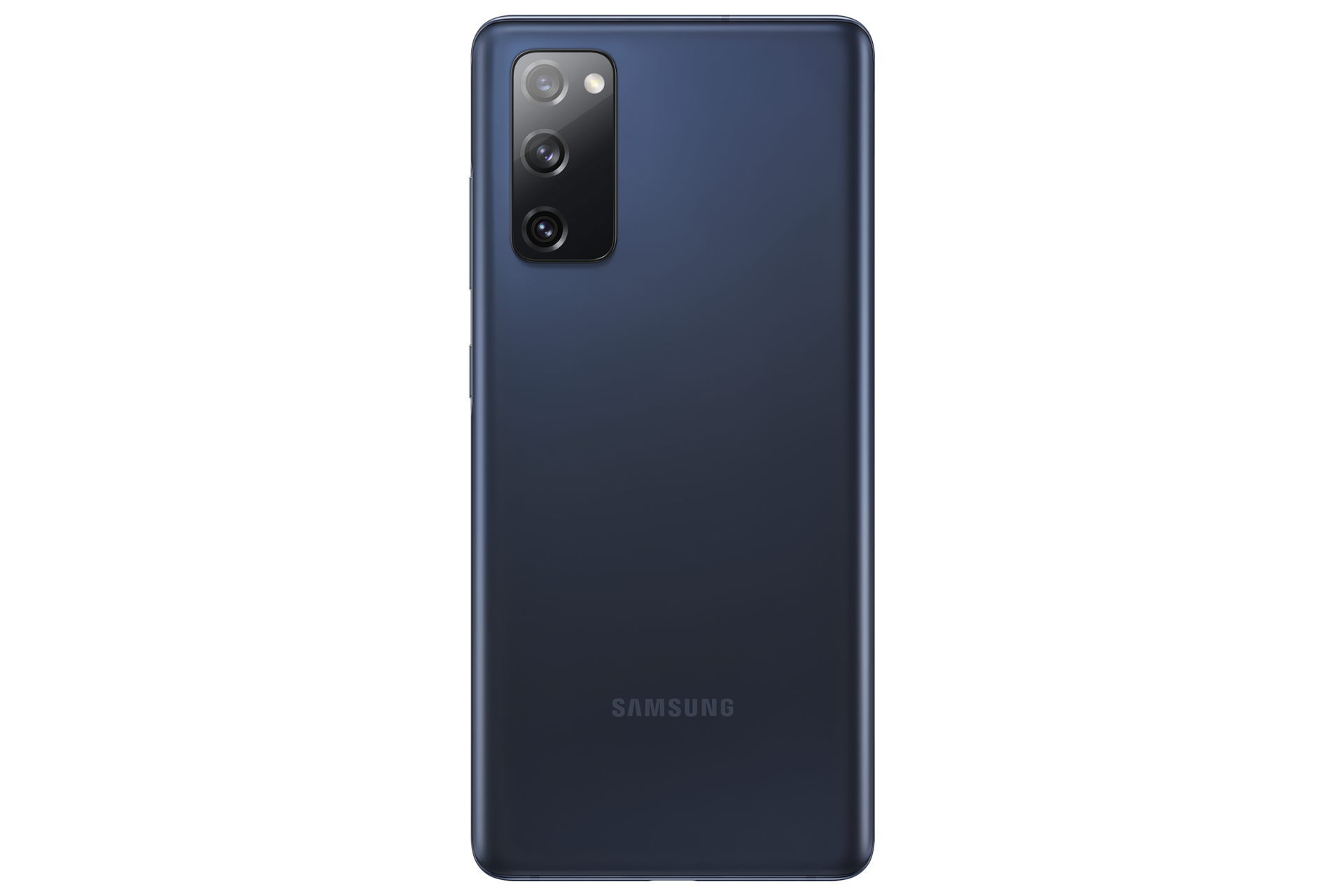
Aucun commentaire: